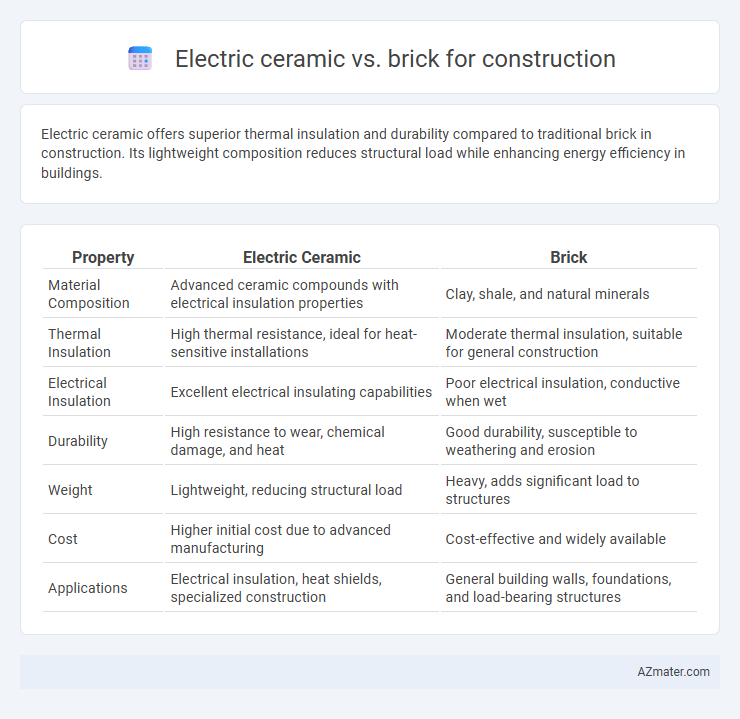Electric ceramic offers superior thermal insulation and durability compared to traditional brick in construction. Its lightweight composition reduces structural load while enhancing energy efficiency in buildings.
Table of Comparison
| Property | Electric Ceramic | Brick |
|---|---|---|
| Material Composition | Advanced ceramic compounds with electrical insulation properties | Clay, shale, and natural minerals |
| Thermal Insulation | High thermal resistance, ideal for heat-sensitive installations | Moderate thermal insulation, suitable for general construction |
| Electrical Insulation | Excellent electrical insulating capabilities | Poor electrical insulation, conductive when wet |
| Durability | High resistance to wear, chemical damage, and heat | Good durability, susceptible to weathering and erosion |
| Weight | Lightweight, reducing structural load | Heavy, adds significant load to structures |
| Cost | Higher initial cost due to advanced manufacturing | Cost-effective and widely available |
| Applications | Electrical insulation, heat shields, specialized construction | General building walls, foundations, and load-bearing structures |
Introduction to Electric Ceramic and Brick in Construction
Electric ceramic materials provide excellent insulation, high heat resistance, and durability, making them ideal for specialized construction applications such as fireproofing and electrical components. Traditional brick remains a widely used construction material due to its strength, thermal mass, and affordability, offering reliable structural support in residential and commercial buildings. Both materials contribute distinct advantages in construction, with electric ceramics excelling in energy efficiency and safety, while bricks provide cost-effective stability and longevity.
Material Composition: Electric Ceramic vs Brick
Electric ceramic is composed primarily of advanced oxide materials, such as aluminum oxide and zirconium oxide, fused at high temperatures to achieve superior thermal resistance and electrical insulation properties. Bricks are traditionally made from clay or shale, which are molded and kiln-fired to create a porous, durable material favored for load-bearing capacity and thermal mass. The distinct material compositions dictate electric ceramic's suitability for high-tech applications, whereas bricks remain a cost-effective choice for structural construction.
Durability and Strength Comparison
Electric ceramic materials exhibit higher durability due to their resistance to extreme temperature fluctuations, chemical corrosion, and wear, making them ideal for long-lasting construction applications. Brick, while strong in compression and widely used for structural stability, tends to be more susceptible to weathering and degradation over time compared to electric ceramics. The superior tensile strength and thermal insulation properties of electric ceramics provide enhanced structural integrity and longevity in construction projects.
Thermal Insulation Properties
Electric ceramic materials typically exhibit superior thermal insulation properties compared to traditional bricks, owing to their low thermal conductivity and engineered microstructure designed to minimize heat transfer. Bricks, while durable and widely used, tend to have higher thermal conductivity, leading to greater heat loss or gain in buildings, which can affect energy efficiency. Incorporating electric ceramic insulative components in construction can significantly enhance thermal performance, reducing heating and cooling costs.
Energy Efficiency in Building Applications
Electric ceramic materials exhibit superior energy efficiency in building applications due to their enhanced thermal insulation properties and ability to regulate indoor temperatures more effectively than traditional brick. These ceramics reduce heat transfer, lowering reliance on heating and cooling systems, which significantly cuts energy consumption. Advanced electric ceramic composites also enable integration with smart energy systems, optimizing energy use and promoting sustainable construction practices.
Cost Analysis: Electric Ceramic vs Traditional Brick
Electric ceramic materials typically have higher upfront costs compared to traditional bricks due to advanced manufacturing processes and enhanced thermal properties. However, electric ceramics offer long-term savings through improved energy efficiency and reduced maintenance expenses. Traditional bricks remain cost-effective for initial investment but may incur higher costs over time due to lower insulation and durability factors.
Sustainability and Environmental Impact
Electric ceramic materials used in construction offer enhanced sustainability compared to traditional bricks due to their lower carbon footprint during production and better energy efficiency in insulation. The manufacturing process of electric ceramics generates fewer greenhouse gas emissions and utilizes less natural raw material, reducing environmental degradation. Bricks, while durable, often involve energy-intensive firing processes and resource extraction that contribute to higher environmental impacts over their lifecycle.
Installation Process and Construction Time
Electric ceramic tiles offer a faster installation process compared to traditional brick walls due to their lightweight design and ease of handling. Electric ceramic systems typically require less curing time, reducing overall construction time significantly. Bricks, on the other hand, demand more labor-intensive laying and longer drying periods, extending the project timeline.
Maintenance and Longevity Considerations
Electric ceramic materials offer superior resistance to moisture, heat, and chemical wear, resulting in lower maintenance requirements compared to traditional brick, which tends to deteriorate over time due to weather exposure and pore absorption. The non-porous nature of electric ceramics minimizes cracking and spalling, extending the longevity of structures by reducing the frequency of repairs and replacements. While brick provides thermal mass benefits, electric ceramic's enhanced durability and easier maintenance make it a cost-effective choice for long-term construction projects.
Choosing the Right Material for Your Project
Electric ceramic offers superior thermal insulation and energy efficiency, making it ideal for projects requiring sustainable building materials, while brick provides robust durability and excellent load-bearing capacity for structural integrity. Electric ceramic's lightweight nature reduces construction time and labor costs compared to the heavier, more traditional brick. Choosing between these materials depends on project priorities such as environmental impact, budget constraints, and specific performance requirements like heat retention or structural strength.

Infographic: Electric ceramic vs Brick for Construction
 azmater.com
azmater.com